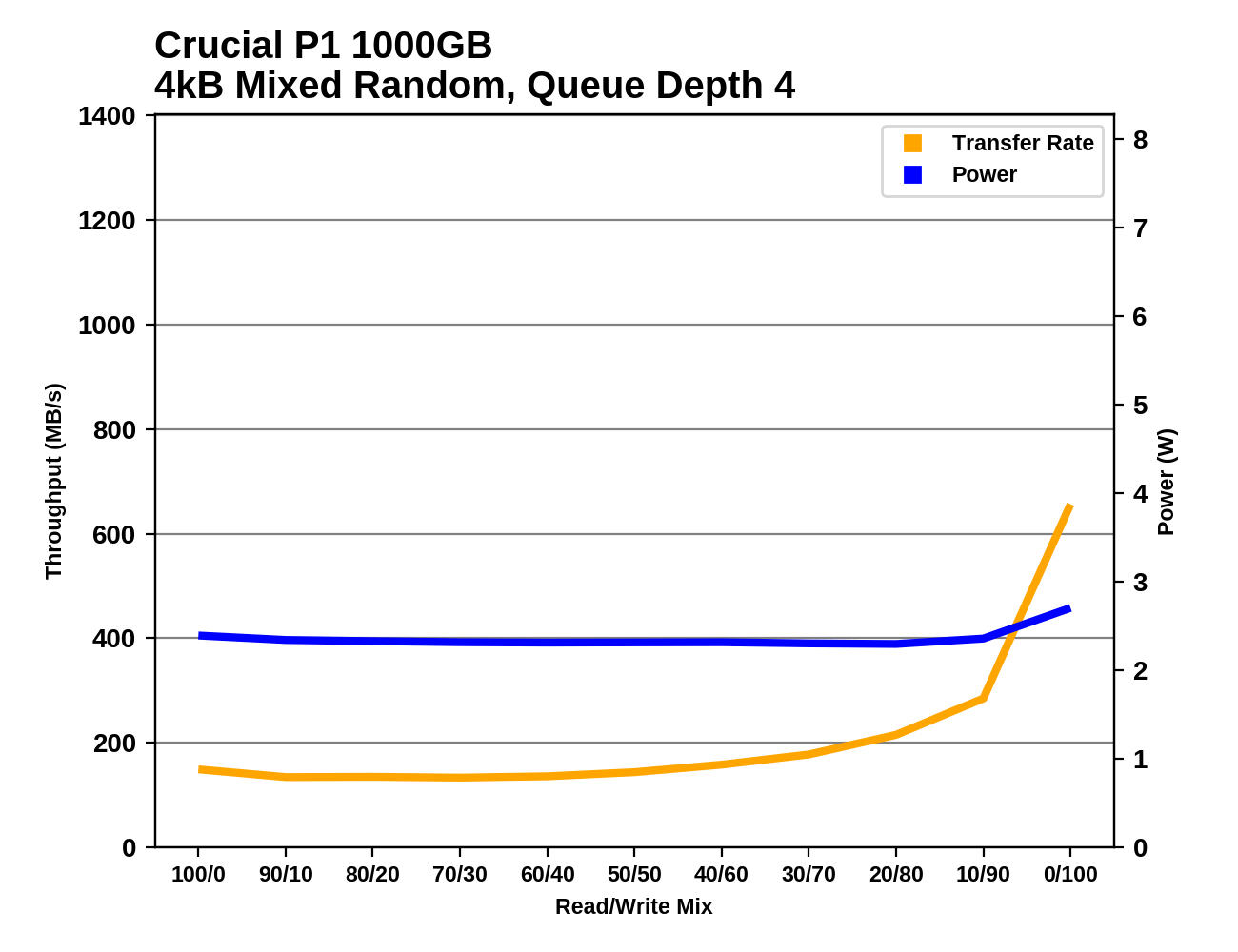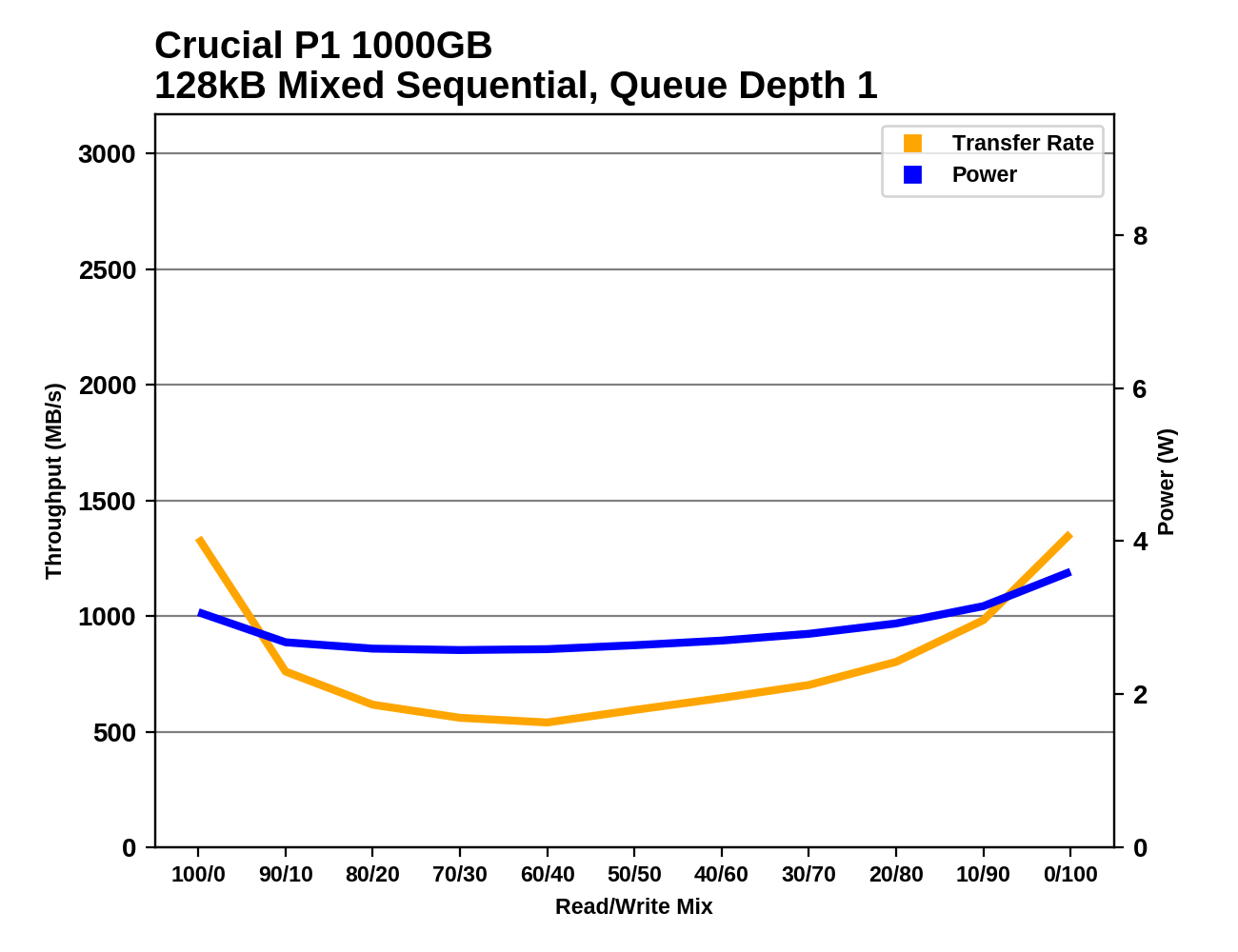The Crucial P1 1TB SSD Review: The Other Consumer QLC SSD
by Billy Tallis on November 8, 2018 9:00 AM ESTMixed Random Performance
Our test of mixed random reads and writes covers mixes varying from pure reads to pure writes at 10% increments. Each mix is tested for up to 1 minute or 32GB of data transferred. The test is conducted with a queue depth of 4, and is limited to a 64GB span of the drive. In between each mix, the drive is given idle time of up to one minute so that the overall duty cycle is 50%.

The Crucial P1 has reasonable entry-level NVMe performance on the mixed random I/O test. It's clearly faster than the MX500 SATA SSD and comes close to some high-end NVMe SSDs. But when the drive is full and the SLC cache is at its minimum size, the P1 slows down to 40% of its speed on a drive containing only the test data. When full, the P1 is about 22% slower than the Intel 660p, but their empty-drive performance is similar.
 |
|||||||||
| Power Efficiency in MB/s/W | Average Power in W | ||||||||
The Crucial P1 has worse power efficiency than the Intel 660p on this test, whether it is run on a full drive or not. The efficiency is still reasonable for the mostly-empty drive test run, but when full the P1's power consumption increases slightly and the efficiency is significantly worse than other low-end NVMe SSDs.
 |
|||||||||
When the mixed random I/O test is run on a full Crucial P1, the benefits of the SLC cache almost completely disappear, leaving the drive with a mostly flat performance curve (with some inconsistency) rather than the significant performance upswing as the proportion of writes grows beyond 70%. The Intel 660p's performance is very similar save for slightly lower write performance to the SLC cache, and slightly improved full-drive performance.
Mixed Sequential Performance
Our test of mixed sequential reads and writes differs from the mixed random I/O test by performing 128kB sequential accesses rather than 4kB accesses at random locations, and the sequential test is conducted at queue depth 1. The range of mixes tested is the same, and the timing and limits on data transfers are also the same as above.

The performance of the Crucial P1 on the mixed sequential I/O test is better than most entry-level NVMe SSDs and comes close to some of the slower high-end drives. Even when the test is run on a full drive, the P1 remains faster than SATA SSDs, and its full-drive performance is slightly better than the Intel 660p.
 |
|||||||||
| Power Efficiency in MB/s/W | Average Power in W | ||||||||
The power efficiency of the Crucial P1 on this test is about average for an entry-level NVMe drive. When the test is run on a full drive, the reduced performance causes efficiency to take a big hit, but it ends up being only slightly less efficient than the Crucial MX500 SATA SSD.
 |
|||||||||
The Crucial P1 has decent performance at either end of the test, when the workload is either very read-heavy or very write-heavy. Compared to other entry-level NVMe drives, the P1 starts out with better read performance and recovers more of its performance toward the end of the test than many of its competitors. The minimum reached at around a 60/40 read/write split is faster than a SATA drive can manage but is unremarkable among NVMe drives. When the test is run on a full drive, performance during the more read-heavy half of the test is only slightly reduced, but things get worse throughout the write-heavy half of the test instead of improving as write caching comes more into play.










66 Comments
View All Comments
Marlin1975 - Thursday, November 8, 2018 - link
" The company's first attempt at an NVMe drive was ready to hit the market but was canceled when it became clear that it would not have been competitive."Looking at this one maybe it should follow the same fate. Or the price should be much lower.
StrangerGuy - Thursday, November 8, 2018 - link
The MSRP for the 1TB is a completely non starter when the excellent EX920 1TB already hit $170, but if the actual price drops to $120 it's definitely appealing especially for a low write count usage like a Steam install drive.FullmetalTitan - Thursday, November 8, 2018 - link
The 970 EVO 1TB NVMe was just on sale for $228 on most retail sites in the US. At the same cost/GB and significantly better performance, it isn't even a question what to buy currently.menting - Thursday, November 8, 2018 - link
comparing sale price vs retail price is pretty meaningless.Billy Tallis - Thursday, November 8, 2018 - link
Given how flash memory prices have been dropping, today's sale price is next month's everyday retail price.DigitalFreak - Friday, November 9, 2018 - link
Just saw the 970 EVO 1TB is $219 at Microcenter. Unless it gets a $50+ price cut immediately, the P1 is DOA.tokyojerry - Friday, April 19, 2019 - link
Currently $128 at Amazon. As of 4/19/2019 3:14:42 PM0ldman79 - Monday, November 12, 2018 - link
I just paid $139 for a WD Blue 1TB 3D m.2 a couple of days ago. Haven't even beaten on it thoroughly.In quick testing (video encoding) during the decompress it will sustain 300MBps for a while, not sure if I'm hitting a drive limit, IO limit or CPU limit shortly there after. The program starts a few other processes, so I'm thinking CPU.
III-V - Thursday, November 8, 2018 - link
They are supposedly having yield issues. If they resolve those, there is plenty of room for cost to come down.Oxford Guy - Thursday, November 8, 2018 - link
Look at what happens with DRAM every time. DDR2 comes out and DDR1 becomes more expensive. Rinse repeat.QLC may lead to higher TLC prices, if TLC volume goes down and/or gets positioned as a more premium product as manufacturers try to sell us QLC.